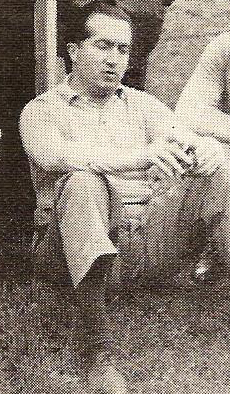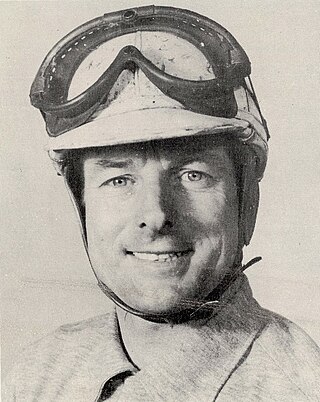
Ray Wade Harroun was an American racing driver and pioneering race car constructor. He is most famous for winning the inaugural Indianapolis 500 in 1911.

The United States Auto Club (USAC) is one of the sanctioning bodies of auto racing in the United States. From 1956 to 1979, USAC sanctioned the United States National Championship, and from 1956 to 1997 the organization sanctioned the Indianapolis 500. USAC serves as the sanctioning body for a number of racing series, including the Silver Crown Series, National Sprint Cars, National Midgets, Speed2 Midget Series, .25 Midget Series, Stadium Super Trucks, and Pirelli World Challenge. Seven-time USAC champion Levi Jones is USAC's Competition Director.

The 1952 Formula One season was the sixth season of FIA Formula One motor racing. It featured the 3rd World Championship of Drivers, which was contested over eight races between 18 May and 7 September 1952. The season also included several non-championship races and a separate East German Championship.

Troy Lynn Ruttman was an American racing driver. He is best known for winning the 1952 Indianapolis 500 - at the age of 22 years and 80 days, Ruttman remains the youngest ever winner of the event. Competing since the age of 15, he had a remarkably successful early career, winning several regional and AAA-sanctioned championships.

Henry Edwin Banks was an American racing driver. He competed in various disciplines of open-wheel motorsport. Banks is best remembered for winning the 1950 AAA National Championship, and for his later career as a USAC race official.

Samuel Dwight Hanks was an American racing driver who won the 1957 Indianapolis 500. He was a barnstormer, and raced midget and Championship cars.
The Dickinson System was a mathematical point formula that awarded national championships in college football. Devised by University of Illinois economics professor Frank G. Dickinson, the system ranked national teams from 1924 to 1940. The 1924 ratings were made retroactively by Dickinson during the 1925 college football season, the first in which a number 1 team was designated at the end of the season. The retroactive choice on October 16, 1925, for the 1924 season was Notre Dame.
The 1905 AAA National Motor Car Championship consisted of 11 points-paying races, beginning in The Bronx, New York on June 10 and concluding in Poughkeepsie, New York on September 29. There were also at least two non-championship events held during the year. This was the first year that the AAA Contest Board officially recognized a National Champion in American Championship Car competition.
The 1909 AAA Championship Car season consisted of 24 races, beginning in Portland, Oregon on June 12 and concluding with a point-to-point race from Los Angeles, California to Phoenix, Arizona on November 6. There were three events sanctioned by the Automobile Club of America in Lowell, Massachusetts. AAA did not award points towards a National Championship during the 1909 season, and did not declare a National Champion.
The 1910 AAA Championship Car season consisted of 19 races, beginning in Atlanta, Georgia on May 5 and concluding in Long Island, New York on October 1. AAA did not award points towards a National Championship during the 1910 season, and did not declare a National Champion.

The 1911 AAA Championship Car season consisted of 21 races, beginning in Oakland, California on February 22 and concluding in Savannah, Georgia on November 30. AAA did not award points towards a National Championship during the 1911 season, and did not declare a National Champion. Ray Harroun was the winner of the inaugural Indianapolis 500.
The AAA Contest Board was the motorsports arm of the American Automobile Association. The contest board sanctioned automobile races from 1904 until 1955, establishing American Championship car racing. Modern-day Indy car racing traces its roots directly to these AAA events.
The 1920 AAA Championship Car season consisted of 5 races, beginning in Beverly Hills, California on February 28 and concluding in Beverly Hills on November 25. The AAA National Champion and Indianapolis 500 champion was Gaston Chevrolet. The 1920 season later became a source of confusion and misinformation for historians when in 1926 the AAA published a revisionist history, naming another driver as the season's point champion.
The 1912 AAA Championship Car season consisted of 18 races, beginning in Santa Monica, California on May 4 and concluding in Brooklyn, New York on November 5. There was also one non-championship event at Milwaukee, Wisconsin. AAA did not award points towards a National Championship during the 1912 season, and did not declare a National Champion. Joe Dawson was the winner of the Indianapolis 500.
The 1914 AAA Championship Car season consisted of 15 races, beginning in Santa Monica, California on February 26 and concluding in Corona, California on November 26. AAA did not award points towards a National Championship during the 1914 season, and did not declare a National Champion. René Thomas was the winner of the Indianapolis 500.
The 1915 AAA Championship Car season consisted of 27 races, beginning in San Diego, California on January 9 and concluding in San Francisco, California on November 25. AAA did not award points towards a National Championship during the 1915 season, and did not declare a National Champion. Ralph DePalma was the winner of the Indianapolis 500.

The 1917 AAA Championship Car season consisted of 21 races, beginning in Los Angeles, California on March 4 and concluding there on November 29. AAA did not award points towards a National Championship during the 1917 season, and did not declare a National Champion.
The 1918 AAA Championship Car season consisted of 16 races, beginning in Uniontown, Pennsylvania on May 16 and concluding there on September 2. There were also 3 non-championship races. AAA did not award points towards a National Championship during the 1918 season, and did not declare a National Champion.
The 1919 AAA Championship Car season consisted of 21 races, beginning in Santa Monica, California on March 15 and concluding in Cincinnati, Ohio on October 12. AAA did not award points towards a National Championship during the 1919 season, and did not declare a National Champion. Howdy Wilcox was the winner of the Indianapolis 500.







